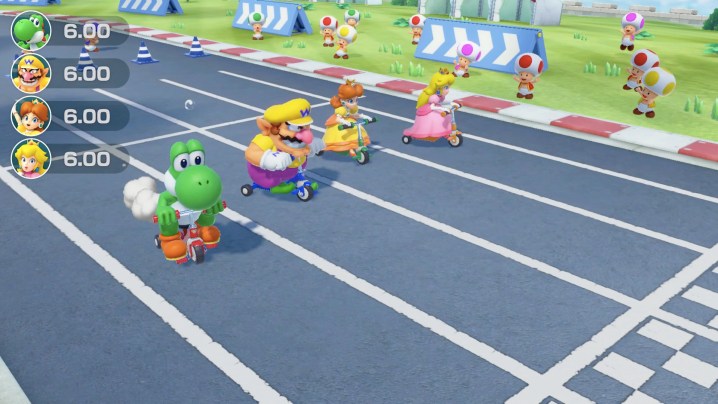
The Mario Party series is probably Nintendo’s longest running series that has never produced a truly amazing entry. Sure, the early Nintendo 64 entries were good and the GameCube follow-ups were decent, but from the Wii onward, Mario Party games have always just kind of been there. While Super Mario Party isn’t the iteration that breaks through to sheer awesomeness, it does bring back some of the feelings of first booting up Mario Party on N64. It introduces some welcomed new features and retains some nagging annoyances. By and large Mario Party’s Switch debut is a fair amount of fun, but the good portion of the party ends a bit too soon.
The original board game formula makes a return in the eponymous mode. Unlike the last mainline entry, you’re back to collecting stars and playing minigames at the end of each turn. The boards themselves feel more alive than previous entries, with vendors, item shops, chance scenarios, and of course, moving star locations. Each board is non-linear, meaning that you make far more choices on which direction you take after rolling your dice. This added strategy helps keep the boards feel fresh.
Additionally, each character has their own unique dice block that can be used instead of the standard 1-6 dice. Choosing to use character dice is a risk-reward system that can net you big moves (like moving ten spaces) or nothing at all (you can roll a zero with some characters). There’s also a clever ally system that lets you stack rolls with a character that follows you around. Your allies sometimes even help you in minigames. All of this leads to more nuanced and often unpredictable board game experience.
It’s easy to outplay your opponents and still lose from terrible luck. Yes, this is a board game and many board games revolve around chance, but it’s frustrating when you win almost all of the minigames and wind up losing because of unfortunate rolls. On top of that, Super Mario Party still has random star giveaways at the end of a match. You can head to the podium with the most stars and still lose because Wario receives a bonus star for moving the least number of spaces. It can easily make trying to win feel like a pointless endeavor.
There are also some issues with pacing. A 10-turn game, the shortest available, takes an hour. That number really could be cut in half if turns didn’t take so long. Super Mario Party sacrifices speed for detailed animations that add personality. For most, though, the little details such as showing the disappointment on an opponents face when you nab a star will become tedious quickly. It’d be nice if you could speed up turns, but alas, you cannot.
As a head’s up, Super Mario Party can only be played with a single Joy-Con for each player. It doesn’t support Pro controllers or handheld mode though it makes great use of the HD Rumble. There’s a minigame where you have to memorize three different rumble patterns and then pick the correct creature when one of the rumbles is repeated. And it actually worked well. The HD Rumble offers such a wide range of vibrations that picking out distinct patterns didn’t feel like a guessing game at all.
Overall, Super Mario Party‘s 80 minigames are pretty solid. There’s a nice balance of games that require motion controls, HD Rumble, and regular controls. In isolation, each party game loses its novelty fairly quickly, but when you compile them together, mix ’em up, and play them during crucial moments when you need coins to buy a star, they do their job fittingly.
Outside of the marquee mode, there are three other main game modes of varying quality. Partner Party, the best of the bunch, pits two teams of two against one another. It’s played on the same boards as the standard Party, but you have grid-based movement, which lets you have more control over where you wind up after a roll. Partner Party is strategic in a way that Mario Party rarely is.
Despite the mostly solid quality of Party mode and Partner Rally, both risk losing their charm when playing Super Mario Party regularly. After playing one of boards four times, it lost its luster quick. It may be fun to go to a party once a week or so, but too much partying can lead to headaches from boredom.
Sound Stage and River Survival, the other two modes, are fun for a go around or two, but they feel tacked on. River Survival is a four-player co-op adventure down a river. Your team races against the clock using motion controls to paddle. Popping balloons allow you to play minigames that add more seconds to the clock. River Survival is hard to fail at, and for that, it probably won’t interest you for very long unless you’re playing with young kids. Sound Stage is a collection of rhythm minigames, such as whacking moles and washing windows on cue. Again, it’s fun at first, but the collection of available games is relatively small.
Super Mario Party takes strides in the right direction after a string of bad parties. It’s fun though it falls short in some respects, but it does the trick for family game night.








